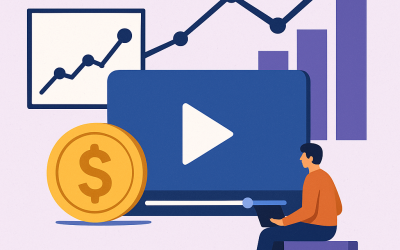Mid-year “Review & Prediction” on Ad Monetization
Global digital ad spending is projected to reach $526 billion this year! That is “B”illion! With such a massive market, optimizing Ad monetization strategies has never been more crucial for businesses and content creators alike.
In this mid-year review, we’ll take a comprehensive look at the current state of ad monetization. We’ll explore key performance metrics, successful strategies, and challenges faced in the first half of the year. Whether you’re a seasoned professional or new to the world of ad monetization, this post aims to provide valuable insights and actionable takeaways to enhance your monetization efforts for the rest of the year.
Contents
- 1 Overview of Ad Monetization
- 1.0.0.1 Banner Ads: These are static or animated images that appear in designated areas on a webpage or app. They are one of the oldest and most straightforward forms of online advertising.
- 1.0.0.2 Video Ads: Video ads can appear as pre-roll, mid-roll, or post-roll ads in video content. They are highly engaging and can capture the audience’s attention more effectively than static ads.
- 1.0.0.3 Native Ads: Native ads blend seamlessly with the content in which they are placed, providing a less intrusive and more integrated advertising experience. Examples include sponsored articles or promoted posts on social media.
- 1.0.0.4 Interstitial Ads: These are full-screen ads that appear at natural transition points in an app or game, such as between levels. They are highly visible and can be very effective but may also disrupt the user experience if not used carefully.
- 1.0.0.5 Rewarded Ads: Commonly used in mobile games, these ads offer users a reward (e.g., extra lives, in-game currency) in exchange for watching an ad. This method tends to have high engagement rates as users receive a tangible benefit.
- 1.0.0.6 Programmatic Advertising: This involves the use of automated systems and algorithms to buy and sell ad space in real-time, often through ad exchanges. It allows for highly targeted and efficient ad placements.
- 1.0.0.7 Affiliate Marketing: In this model, publishers earn a commission by promoting other companies’ products or services and driving sales or conversions through their content.
- 2 Key Metrics and KPIs
- 2.0.0.0.1 CPM (Cost Per Mille): CPM measures the cost of 1,000 ad impressions. It is a common metric for brand awareness campaigns, indicating how much advertisers are willing to pay to reach a thousand viewers. High CPM rates usually reflect high-value audiences or premium ad placements.
- 2.0.0.0.2 CPC (Cost Per Click): CPC indicates the cost an advertiser pays for each click on their ad. This metric is crucial for performance-based advertising, where the goal is to drive traffic to a website or app. It helps in assessing the effectiveness of ad creatives and targeting strategies.
- 2.0.0.0.3 CTR (Click-Through Rate): CTR is the percentage of ad impressions that result in a click. It is calculated by dividing the number of clicks by the number of impressions and multiplying by 100. A high CTR often signifies that the ad content is relevant and engaging to the audience.
- 2.0.0.0.4 Fill Rate: Fill rate measures the percentage of ad requests that are successfully filled with ads. It is calculated by dividing the number of ads served by the number of ad requests. A high fill rate indicates efficient ad inventory usage and strong demand from advertisers.
- 2.0.0.0.5 eCPM (Effective Cost Per Mille): eCPM is a derived metric that represents the estimated earnings per 1,000 impressions. It is calculated by dividing total earnings by the number of impressions (in thousands). eCPM helps compare revenue performance across different ad formats and networks.
- 2.0.0.0.6 ARPU (Average Revenue Per User): ARPU measures the revenue generated per user, providing insights into how effectively the audience is being monetized. It is particularly useful for mobile apps and games to understand the revenue contribution of each user.
- 2.0.0.0.7 LTV (Lifetime Value): LTV estimates the total revenue a user will generate over their entire relationship with the app or platform. It helps in understanding the long-term value of users and in making informed decisions about user acquisition and retention strategies.
- 2.0.0.0.8 Ad Viewability: This metric measures the percentage of ads that are actually viewable by users. An ad is considered viewable if at least 50% of it is visible on screen for at least one second (for display ads) or two seconds (for video ads). High viewability rates are essential for ad effectiveness and advertiser satisfaction.
- 3 Mid-Year Review of 2024
- 4 Mid-Year Prediction for remaining 2024
- 4.0.1 Hybrid Monetization Models
- 4.0.2 Evolution of Ad Formats
- 4.0.3 Personalization and Targeting
- 4.0.4 Shift in Monetization Strategies for Hybrid-Casual Games
- 4.0.5 Cross-Channel User Acquisition
- 4.0.6 AI-Driven Targeting and Personalization
- 4.0.7 Optimized Ad Placements and Formats
- 4.0.8 Balance Between Revenue and User Experience
- 4.0.9 Genre-Specific Monetization
- 4.0.10 Personalized Offers
Overview of Ad Monetization
 Ad monetization is the process of generating revenue by displaying advertisements on digital platforms such as websites, mobile apps, and social media channels. It enables content creators, publishers, and app developers to earn money from their online presence by leveraging the traffic and user engagement they generate.
Ad monetization is the process of generating revenue by displaying advertisements on digital platforms such as websites, mobile apps, and social media channels. It enables content creators, publishers, and app developers to earn money from their online presence by leveraging the traffic and user engagement they generate.
In an increasingly digital world, ad monetization is crucial for sustaining free content and services. It provides a steady income stream that supports the creation and maintenance of digital content, allowing businesses to invest in better user experiences and innovation. Effective ad monetization can significantly impact a company’s bottom line and overall financial health. There are several common methods of ad monetization, each with its own advantages and use cases:
-
Banner Ads: These are static or animated images that appear in designated areas on a webpage or app. They are one of the oldest and most straightforward forms of online advertising.
-
Video Ads: Video ads can appear as pre-roll, mid-roll, or post-roll ads in video content. They are highly engaging and can capture the audience’s attention more effectively than static ads.
-
-
Interstitial Ads: These are full-screen ads that appear at natural transition points in an app or game, such as between levels. They are highly visible and can be very effective but may also disrupt the user experience if not used carefully.
-
Rewarded Ads: Commonly used in mobile games, these ads offer users a reward (e.g., extra lives, in-game currency) in exchange for watching an ad. This method tends to have high engagement rates as users receive a tangible benefit.
-
Programmatic Advertising: This involves the use of automated systems and algorithms to buy and sell ad space in real-time, often through ad exchanges. It allows for highly targeted and efficient ad placements.
-
Affiliate Marketing: In this model, publishers earn a commission by promoting other companies’ products or services and driving sales or conversions through their content.
Each of these methods offers unique benefits and can be tailored to fit different types of content and audience preferences. In the following sections, we’ll delve deeper into the performance and trends of these ad monetization strategies over the past six months.
Key Metrics and KPIs
Important Metrics: Understanding and tracking key performance indicators (KPIs) is essential for evaluating the success of ad monetization strategies. Here are some of the most important metrics used in the industry:
-
-
CPC (Cost Per Click): CPC indicates the cost an advertiser pays for each click on their ad. This metric is crucial for performance-based advertising, where the goal is to drive traffic to a website or app. It helps in assessing the effectiveness of ad creatives and targeting strategies.
-
CTR (Click-Through Rate): CTR is the percentage of ad impressions that result in a click. It is calculated by dividing the number of clicks by the number of impressions and multiplying by 100. A high CTR often signifies that the ad content is relevant and engaging to the audience.
-
Fill Rate: Fill rate measures the percentage of ad requests that are successfully filled with ads. It is calculated by dividing the number of ads served by the number of ad requests. A high fill rate indicates efficient ad inventory usage and strong demand from advertisers.
-
eCPM (Effective Cost Per Mille): eCPM is a derived metric that represents the estimated earnings per 1,000 impressions. It is calculated by dividing total earnings by the number of impressions (in thousands). eCPM helps compare revenue performance across different ad formats and networks.
-
ARPU (Average Revenue Per User): ARPU measures the revenue generated per user, providing insights into how effectively the audience is being monetized. It is particularly useful for mobile apps and games to understand the revenue contribution of each user.
-
LTV (Lifetime Value): LTV estimates the total revenue a user will generate over their entire relationship with the app or platform. It helps in understanding the long-term value of users and in making informed decisions about user acquisition and retention strategies.
-
Ad Viewability: This metric measures the percentage of ads that are actually viewable by users. An ad is considered viewable if at least 50% of it is visible on screen for at least one second (for display ads) or two seconds (for video ads). High viewability rates are essential for ad effectiveness and advertiser satisfaction.
 Mid-Year Review of 2024
Mid-Year Review of 2024
As we reach the midpoint of 2024, it’s time to reflect on the significant trends and shifts in ad monetization that have shaped the industry over the past six months. Here’s a detailed look at the most notable developments:
-
Hybrid Monetization Models Gain Traction
Trend Overview: Mobile game publishers are increasingly adopting hybrid monetization models that combine in-app advertising (IAA) and in-app purchases (IAP).
Implications: This approach allows publishers to diversify their revenue streams, balancing ad revenue with direct purchases from users. It indicates that ad revenue remains a substantial component of overall earnings for many mobile games.
Case Example: Popular mobile games are leveraging rewarded video ads to enhance user experience while generating significant ad revenue alongside in-app purchases.
- Rise of Ad-Supported Subscription Video (SVAD)
Trend Overview: Ad-supported subscription video is becoming more prevalent among streaming services.
Implications: Subscription-based OTT companies are incorporating ad-supported tiers to attract price-sensitive consumers and expand their user base. Although some services may take time to see substantial returns, this model provides a pathway to increase revenue and user engagement.
Case Example: Services like Netflix and Disney+ are exploring ad-supported options to complement their subscription offerings.
-
Growth in Ad Revenue for Major Streaming Platforms
- Paramount+: Achieved a 61% year-over-year revenue growth in Q3 2023, fueled by both subscriber growth and increased ad revenue.
- Roku: Reported an 18% year-over-year increase in platform revenue to $787 million in Q3, primarily driven by content distribution and video advertising.
- Warner Bros. Discovery: Saw a 30% increase in Q3 2023 advertising revenue, reaching $138 million.
- Peacock: Experienced a 64% revenue increase to $830 million in Q3 2023.
Implications: These figures underscore the significant role that ad revenue plays in the financial health of streaming platforms. The trend towards ad-supported models is yielding positive results, contributing to overall growth.
-
Evolution of the Mobile Ad Industry
eCPM Variations: Effective cost per mille (eCPM) rates are showing diverse trends across different markets, platforms, and ad types.
- United States: Maintained stable and high eCPM rates for rewarded video ads, with Android platforms peaking at $19.21 and iOS at $17.84 in June.
- Canada and Australia: Experienced declining eCPM trends, particularly on iOS platforms.
- France and Germany: Demonstrated stable eCPM rates, especially on iOS.
Implications: These variations highlight the dynamic nature of the mobile ad market. Advertisers and publishers must stay agile, adapting strategies to leverage high eCPM markets while addressing challenges in others.
-
Streamlined YouTube Monetization Processes
Improvement Overview: In 2024, YouTube has optimized its monetization process, enabling channels that meet the requirements (1,000 subscribers and 4,000 public watch hours) to potentially get monetized within a day.
Implications: The expedited review process, taking approximately 10 hours, allows content creators to start earning revenue faster. This efficiency can significantly impact the growth and sustainability of new YouTube channels.
-
Shift in Ad Budgets to Streaming Services
Trend Overview: There is a noticeable shift in advertising budgets from social media platforms to streaming services.
Implications: This shift reflects a changing landscape in video advertising, where advertisers are recognizing the value of targeting engaged viewers on streaming platforms. The move suggests that streaming services offer more effective and scalable ad opportunities compared to traditional social media channels.
Mid-Year Prediction for remaining 2024
Ad Monetization is evolving, and strategies are becoming increasingly sophisticated and diverse. From what we have seen so far, here are the key trends shaping ad monetization for the remaining of 2024:
-
Hybrid Monetization Models
Trend Overview: Mobile game publishers are increasingly adopting hybrid monetization models that combine in-app advertising (IAA) with in-app purchases (IAP).
Implications: This dual approach maximizes revenue potential by providing players with options: they can either watch ads for rewards or make direct purchases. This flexibility enhances player experience while optimizing monetization strategies.
-
Evolution of Ad Formats
Rewarded Ads: These continue to gain popularity, offering players in-game rewards (like extra lives, coins, or bonuses) in exchange for watching short video ads or engaging with other ad content. This method encourages voluntary ad consumption, boosting engagement.
Playable Ads: Emerging as an effective way to captivate audiences, playable ads allow players to interact with mini-versions of advertised games. This hands-on experience can lead to higher conversion rates as players get a taste of the game before downloading it.
-
Personalization and Targeting
Advanced Techniques: Advertisers are leveraging user data and machine learning algorithms to create hyper-targeted ad content based on demographics, interests, and previous gaming behavior.
Benefits: This personalized approach increases engagement and conversion rates by ensuring that ads are relevant and appealing to specific user segments.
-
Shift in Monetization Strategies for Hybrid-Casual Games
Trend Overview: Many hybrid-casual games are shifting their focus more towards in-app purchases rather than relying solely on ad revenue.
Implications: By enhancing the in-game economy and offering valuable purchasable content, developers can drive higher revenue while maintaining a seamless user experience.
-
Cross-Channel User Acquisition
Diversification: Developers are expanding their user acquisition strategies across multiple channels, including in-app ads, social media campaigns, and influencer partnerships.
Implications: This multi-faceted approach helps reach a broader audience, driving user growth and increasing ad revenue opportunities.
-
AI-Driven Targeting and Personalization
Trend Overview: Artificial intelligence is being utilized to refine targeting strategies and personalize ad experiences.
Benefits: AI helps predict purchasing behaviors and tailor ads to specific user segments, improving ad relevance and effectiveness.
-
Optimized Ad Placements and Formats
User-Initiated Formats: Developers are focusing on user-initiated ad formats like rewarded videos and offerwalls. These formats enhance user engagement and satisfaction by providing tangible rewards for ad interactions.
Implications: Effective ad placements ensure that ads do not disrupt the gaming experience, maintaining a balance between monetization and user enjoyment.
-
Balance Between Revenue and User Experience
Developer Strategies: Game developers are striving to align their monetization methods with player preferences, ensuring a positive gaming experience while generating revenue.
Implications: This balance is crucial for long-term success, as overly aggressive monetization can lead to player churn.
-
Genre-Specific Monetization
Trend Overview: Different game genres are seeing varied success with monetization strategies.
Insights: RPGs, strategy games, and match-3 games continue to dominate in-app purchase spending, while casual games often rely more on ad revenue.
-
Personalized Offers
Consumer Behavior: Over 40% of IAP spenders indicate they would be willing to spend more on personalized offers.
Implications: Tailored promotions and offers can significantly boost revenue, highlighting the importance of understanding and catering to individual player preferences.
To conclude, these trends suggest that while ad monetization remains a crucial revenue stream for digital content creators and platforms, the strategies and performance vary across different sectors and markets. Publishers and advertisers are continually adapting to changing consumer behaviors and technological advancements in the ad tech space.



